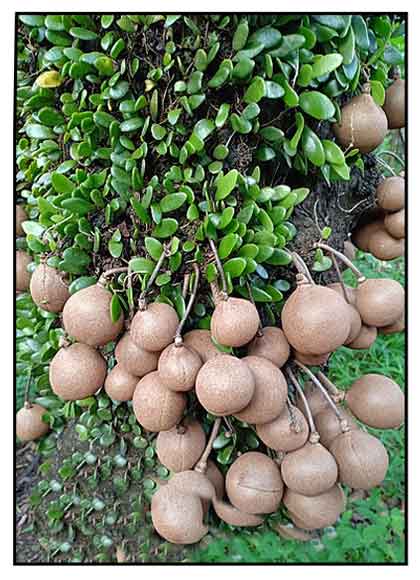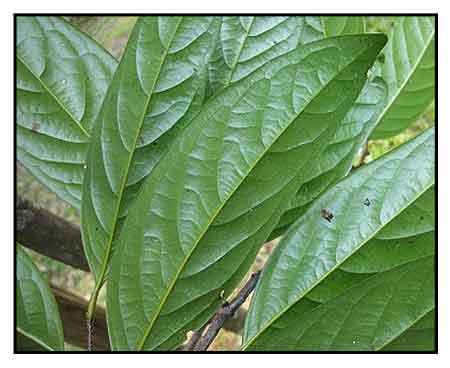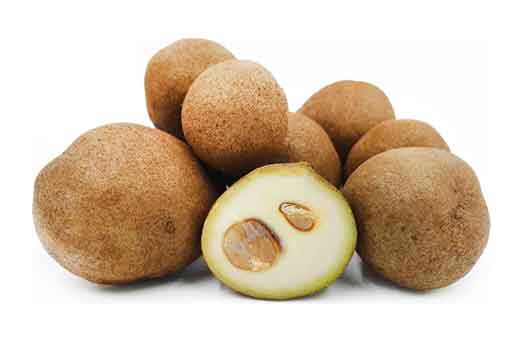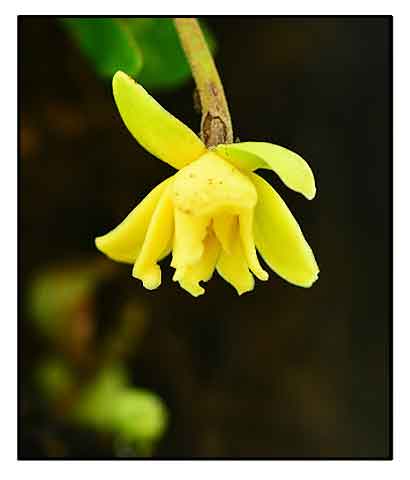 Gen info Gen info
- The genus epithet 'Stelechocarpus' derives from Greek 'stelecho' meaning 'trunk, branch, stem' and 'karpos' meaning fruit, referring to the cauliflorus nature of the species and how the fruits are borne directly on the main woody parts of the tree. (3)
- The common name 'Kepel' means 'of clenched fist' in Malay, alluding to the fist-sized fruits. (3)
- Due to low economic value, the cultivation program for this plant species is almost abandoned.
Botany
Stelechocarpus burahol is a medium-sized evergreen tree up to 25 m tall. Crown is conical, with symmetrical lateral branching. Mature bark is dark brown, scaly, flaking off in places. Leaves are leathery, prominently veined; young flush emerge deep red, maturing to pinkish, light green and then dark green, each episode of flushing lasting 2 months, usually before blooming and after fruit drop. Flowers are in clusters of 8-16, emerging greenish and whitish on aging. Species is monoecious (separate male and female on same plant) and exhibits cauliflory. Male flowers are 1 cm across, on upper trunk and older branches. Female flowers occur only on lower trunk. Pollinated female flowers give rise to tennis-ball sized fruits (5-6 cm across), ripening from green to brown, with slightly warty texture. Fruit is ripe when yellow or light brown beneath scratched skin, containing edible, orange juicy pulp with spicy mango-like flavor. Seeds are ellipsoidal, relatively large, 3 cm long, and 4-6 per fruit. (3)
 Botany Botany
Stelechocarpus burahol is a medium-sized evergreen tree up to 25 m tall. Crown is conical, with symmetrical lateral branching. Mature bark is dark brown, scaly, flaking off in places. Leaves are leathery, prominently veined; young flush emerge deep red, maturing to pinkish, light green and then dark green, each episode of flushing lasting 2 months, usually before blooming and after fruit drop. Flowers are in clusters of 8-16, emerging greenish and whitish on aging. Species is monoecious (separate male and female on same plant) and exhibits cauliflory. Male flowers are 1 cm across, on upper trunk and older branches. Female flowers occur only on lower trunk. Pollinated female flowers give rise to tennis-ball sized fruits (5-6 cm across), ripening from green to brown, with slightly warty texture. Fruit gives an edible, orange juicy pulp with spicy mango-like flavor. Fruit is ripe when scratched skin becomes yellow, orange, or light brown underneath; a green color indicates fruit is immature. Seeds are ellipsoidal, relatively large, 3 cm long, and 4-6 per fruit. (3)
 Distribution Distribution
- Recently introduced.
- Native to Borneo, Java, Lesser Sunda Is., Malaya.
- Grows primarily in wet tropical biome(s). (1)
- Considered rare and endangered.
Constituents
- In a study of fruit pulp for antioxidant activity, a methanolic extract yielded total phenolic content of 58.28 ± 0.37% wt/wt gallic acid equivalent. Petroleum ether soluble fraction revealed a flavonoid content of 76.06 ± 11.9% as rutin equivalent. Based on coefficient (R2) values, phenolics and flavonoids contributed 73.09% and 30.99% towards antiradical scavenging activities. (see study below) (6)
- Study of ethyl acetate fraction of S. burahol fruit yielded total flavonoid content of 0.8333 mg/g quercetin equivalent. (7)
- Study of fruit revealed a significant content of antioxidative compounds. Antioxidative analysis using DPPH, the lowest IC50 was shown by n-butanol extract of flower (22.44 ppm) and ethyl acetate extract of fruit (29.12 ppm). Flower part showed low IC50 of EA extract (35.07 ppm. Further purification through fractionation process was followed by decrease of anti-oxidative activity. (11)
Properties
- Known as an oral deodorant, especially the peel. After eating the aromatic fruit, the body exudes a scent of roses; even sweat and urine may smell of violets.
- Study has shown that it can reduce the odor of feces by activating probiotic bacteria Bifidobacterium bifidum.
- Studies have suggested antioxidant, deodorant, antibacterial, COX inhibitory, anti-gout, wound healing, anti-implantation properties.
Parts used
Fruit, leaves.
 Uses Uses
Edibility
- Ripe fruit is edible, with a coconut or mango flavor.
- Unripe fruits is unpalatable, sour and bitter.
-
Fruit can be made into sherbet, blended into juices, smoothies and beverages, or used as fresh topping over salads, porridge and desserts. (16)
Folkloric
- No reported folkloric medicinal use in the Philippines.
-
Traditionally used in Java as an oral deodorant. Of the pulp, seed, and peel, the peel is considered to have the best absorbent ability.
- Fruit used for gout and as diuretic.
- Leaves used to lower cholesterol.
Fruit use to prevent kidney inflammation. (2)
- Fruit believed to be used by Javanese princesses as contraception. In Java, use was traditionally restricted to the consorts of the sultan of Yogya. (2)
Others
- Wood: Used for making house tools.
- Rituals / Symbolism / Superstition: Fruit is identity flora of Daerah Istimewa Jogjakarta. In ancient times, fruits were primarily consumed by royalty, and non-royal residents were forbidden to eat the fruit. It is loved by Javanese princesses who consider it a symbol of unity and mental and physical integrity. It can still be seen through palace gardens or entrance of palace gates in present day. The tree is shunned by common people who believed planting it will bring a curse--which may have contributed to making the tree rare.
Studies
• Fruit as Oral Deodorant / Adsorbent and Probiotic Mechanism: Study evaluated herbal kepel as deodorant agent for reducing fecal odorants (ammonia, trimethyl-amine and phenol). Pharmacological screening measured the absorbent activities of Kepel's fruit (pulp, seed, and peel) to odorants emitted from feces, such as ammonia (NH3) and methyl-mercaptan (CH3SH). In vivo test was performed orally on rats. Fruit pulp powder was regarded as best absorbent agent (adsorbed 62.96 and 77.78% for NH3 and CH3SH, respectively). All fecal odorant on 3rd and 7th day showed significant decrease (p<0.05). Beside odorant adsorption, it also activated probiotic Bifidobacter sp. by increasing its population. Results suggest potential as an oral deodorant through adsorbent function and probiotic function by enhancing Bifidobacteria growth. (4)
• COX-2 Inhibitor / Anti-Gout / Leaves and Fruits: In Indonesia, kepel is reported to have anti-gout activity. Study screened the cyclooxygenase 2 (COX-2) inhibitor activities of leaves and fruits extracts of kepel. Results showed water extracts and methanol extracts of leaves and water extract of fruits showed inhibitory activities of about 51%. Fruit hexane and EA extract of leaves only showed 20% inhibition. (5)
• Antioxidant / Fruit Pulp: Study evaluated the antioxidant activity of extracts and fractions of fruit pulp of S. burahol based on radical scavenging using ABTS and DPPH assays. The ethyl acetate fraction exhibited highest antiradical antioxidant activity towards ABTS with IC50 of 0.35 µg/ml, lower than vitamin C (positive control). It also showed highest antiradical activity using DPPH assay. (see constituents above) (6)
• Antimicrobial Against Oral Bacteria / Fruit: Study evaluated an ethyl acetate fraction of S. burahol fruit for inhibitory effect on growth of oral bacteria using disc diffusion and microdilution methods. Results showed the EA fraction could inhibit growth of P. gingivalis and F. nucleatum with concentration of 1% w/v, and MIC of 125 µg/ml. Total flavonoid content was 0.8333 mg/g quercetin equivalent. Results suggest the EA fraction contained flavonoid that can be used as antimicrobial against oral bacteria. (7)
• Anti-Implantation Activity / Fruit Pulp: Kepel has been used as contraceptive remedy in Indonesian traditional Javanese royal family. Few studies have been done on the toxic effect of kepel fruit. Study evaluated the effects of kepel fruit extract on percentage of fetus death, ovaries weight, and endometrial thickness in female mice. It showed no significant effect on ovaries weight and endometrial thickness. . Results suggested that kepel pulp ethanol extract is a potential source for natural implantation compounds. (8)
• Antihyperuricemic Activity / Leaves: Study evaluated the ethanol extract of dried powdered leaves of Annona muricata, A. squamosa, A. reticulata, and Stelechocarpus burahol for antihyperuricemic activity. All the ethanolic extracts had significant effect on oxonate-induced hyperuricemic rats, although less inhibitory effect on XO activity in vitro assay. The S. burahol extract was more potent than the other three extracts. It decreased uric acid level equal to level of normal control. (9)
• Acute Toxicity Study / Leaves: Study evaluated the acute effect of Kepel leaves extract after a single oral dose treatment (0, 200, 5875, 1711, and 5000 mg/kbw) on body weight and organs of male and female Sprague-Dawley rats observed for 14 days. There was no death among tested animals, with no toxic effect on body weight and organs of male and female SD rats. Results showed the ethanol extract of leaves was practically non-toxic, and the pseudo-lethal dose of 50% (pseudo LD50) value was higher than 5000 mg/kbw. (10)
• Mouthwash Formulation for Halitosis: Cross-over design, randomized controlled trial in healthy subjects evaluated the bad mouth deodorization activity of burahol mouthwash. Methyl mercaptan capturing activity of burahol fruits was evaluated using gas chromatography. Subjects were treated by burahol mouthwash and a commercial mouthwash containing green tea extract was used as positive control. The burahol mouthwash showed no antibacterial activity against P. gingivalis. It reduced the volatile sulfur compounds (VSCs) concentration. The activity was not statistically different compared to positive control (p<0.05)/ Results showed S. burahol fruits possess bad mouth-odor reducing activity. (12)
• Fruit Lozenges for Halitosis: Cross-over, randomized control trial evaluated the effect of lozenges containing kepel fruit in controlling oral malodor in 30 subjects receiving kepel, xylitol, and placebo lozenges. Effect of burahol fruit extract lozenges was comparable to that of xylitol gum in reducing the H2S, CH3SH, and (CH3)2S levels and organoleptic scores of subjects. Results suggest burahol fruit extract lozenges were effective in controlling oral malodor. (13)
• Healing of Burn Wounds / Leaves: Study evaluated the effect of 80% ethanol extract of burahol leaf formulated as ointment on healing of burn wounds in Sprague-Dawley rats, measuring four parameters: number of macrophages, density of fibroblasts, rate of re-epithelization and decrease in burn wound surface area. Ointment concentrations of 3.25%, 6.5%, and 13%m were used, with vaselin flavum as negative control and silver sulfadiazine as positive control. Results showed the burahol leaf extract ointment can accelerate the healing of wound burns, with best results at 13% concentration, which was comparable to silver sulfadiazine. (14)
• Encapsulation of Kepel Flavonoid / Seeds: Kepel fruit is 27% seed, and only 47% of the fruit is consumed. Disposed seeds generate waste. It is known that kepel seeds contain flavonoids and tannins. Study evaluated the extraction and encapsulation of flavonoids, using a crosslinker agent of natrium tripolyphosphate (NaTTP) for protection of flavonoid content as antioxidant. All powder Kepel seed extract contained flavonoids. Highest total flavonoid content was obtained with 50% ethanol concentration with 2.427% for one hour and 2.888% for two hours. (15)
Availability
Wild-crafted.
Seeds, powdered leaves in the cybermarket. |

![]()







